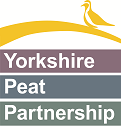In the midst of the doom and gloom headlines of declining wildlife numbers and increasing global temperatures, it is refreshing and reassuring to see restoration success in the field. YPP carried out bare peat revegetation on Glaisdale moor in the North York Moors in 2010 using heather bale bunds (a kind of embankment), grass and heather seed, and chopped-heather brash. Across 1.88ha of bare peat and mineral soil, we installed lines of heather bale bunds to partition the larger areas into smaller cells, and so reduce erosion from water flow and wind. Then we covered the cells with a mix of grass and heather seed and brash to create a micro-climate for the seeds to germinate. Bare peat oxidises, creating extremely acidic conditions, so we applied lime and fertiliser to create better growing conditions for the seed.
We love it when a plan comes together...
Spreading lime at Glaisdale © Peter Christopherson
In November 2018, we went back to Glasidale to survey as part of a feasibility study for the Estate’s Countryside Stewardship application. Of the large, bare area we treated in 2010, only small fragments remained as much of it was now covered in vegetation. Common cotton grass has colonised wetter areas and the heather bales have trapped silt, allowing mosses and grasses to stabilise the trapped material. The heather bales have become so much a part of the landscape, with moss and heather growing on them that it took a few seconds to realise they were there.
This revegetation is even more evident when we look at the aerial photographs before and after bare peat treatment.
We are hoping to continue the restoration of Glaisdale moor, tackling larger gullies, as part of the Estate’s Countryside Stewardship agreement. In the meantime, though, it’s exciting to see just what a positive effect our restoration has had on this site.






